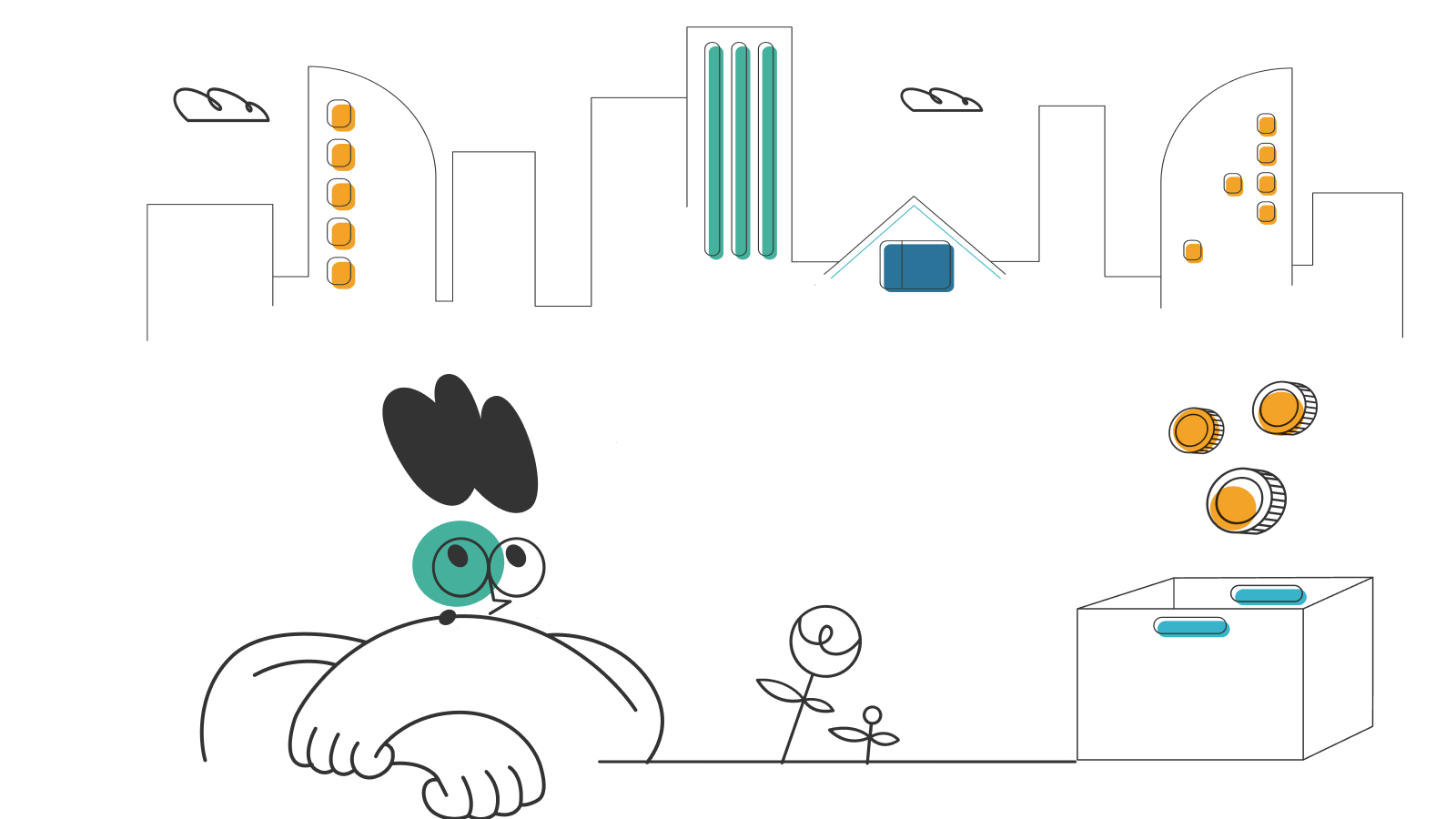Car Trailer vs. Tow Dolly

Moving soon? Get organized with our free moving checklist.
Perhaps hiring an auto transport company is the solution. Unfortunately, these services can be costly.
If you want budget-friendly alternatives, invest time driving your car and choose a DIY car shipping method: a car trailer or tow dolly.
This article will go over each car shipping method. We’ll touch on the basics, differences, pros, and cons. Then, we’ll help you choose between a car trailer or tow dolly as the ideal method.
What are car trailers?
A car trailer is a car carrier that is a four-wheel vehicle for moving a car. It lifts a car (to be towed) off the ground and carries it to another location on its carrier. Think of it like a piggyback ride except the car trailer holds the car and the towing car is giving the ride. All four wheels of the towed car have zero contact with the ground when it is towed.
Fairly enough, it’s hard on a car trailer or for any vehicle that handles the towing. But, know that the car inside the trailer is safe and sound.
What are tow dollies?
A tow dolly is a car carrier where the car is towed with its rear wheels on the ground and front wheels on a dolly. The general design of a tow dolly revolves around the transport or moving of a car in an instant. Car manufacturers also offered it to the public for a fast and easy loading/unloading of front-wheel drives.
A unique way to describe a tow dolly is to think of it as a car wheelbarrow. When using it, you’ll load the front wheels of the car (to be towed) into this car wheelbarrow — a smaller car carrier. Once the car is on a dolly, you can navigate it to a different location with its rear wheels on the ground.
Car trailer vs. tow dolly: Main differences
It’s vital to learn the differences between the two car shipping methods. This way, you can choose an ideal car shipping method. Plus, it positions you to avoid driver and human error.
Functionality
A car trailer and a tow dolly are both highly functional. Their design is to carry vehicles, and they both can accomplish the job but they work a bit differently.
Both car carriers work fine if you properly balance the car in tow. If you overload the back of a towing vehicle, chances are that you could damage that vehicle — to the point of breaking its axle and rendering it unusable.
A car trailer carries all portions of a car in tow. No part of the car is out in the open and exposed to the elements like heavy winds or sand.
Meanwhile, a tow dolly only carries half (or the front portion) of a car and leaves its two back wheels on the ground. As a result, this exposes the towed car and makes it more prone to damage.
Convenience
Most people who want to move cars want an effortless process. Sadly, using a DIY car shipping method means that this process won’t be effortless from the get-go. Both options require a learning curve and attention to detail.
Many car shipping companies may also provide in-depth instructions on how to use the towing rental equipment. As their customer, they want to accommodate you as much as possible. But, they may not provide further assistance because of liability reasons.
Between a car trailer and a tow dolly, the more convenient option is a car trailer. Getting your car into a car trailer is less challenging than hooking it up to a tow dolly. All you need to do is drive it into the trailer.
It’s not the same with a tow dolly. With a tow dolly, loading your car on it can be challenging. It also requires a lot of “trial and error” processes. And after you load your car on a tow dolly, you need to ensure it’s still operable.
Speed
Standard car shipping companies advise going slow — specifically, driving at a maximum speed of 55 mph. They also suggest that when towing a load with a wide wheelbase, turn widely at curves and corners. Plus, if you see a car trailer or tow dolly sway or resist turns, you may need to slow down.
The objective is to help you avoid accidents. If you don’t take a precautionary measure, a car trailer or tow dolly may hit sidewalks, curbs, and signs on the road.
If you’re using a car trailer, you may find it tempting to go beyond this limit. After all, driving a car trailer with a car in tow is like another ordinary day of driving a car. But, avoid doing so and remind yourself you are the driver of precious cargo.
Meanwhile, because a tow dolly sways at accelerated speeds and doesn’t feature brakes, it’s ideal to go below the advised maximum speed. Otherwise, you may not slow down in time. You may hit things that cause the tow dolly to break and incur minor or severe damage to the car in tow.
Driver safety
Whether using a car trailer or a tow dolly, you’ll experience limited visibility when towing a car. This is a problem if you’re on the road with heavy traffic and surrounded by many cars.
It’s also worth noting that when towing a car you will find that the car in tow and the towing vehicle contain more mass when towing. As a result, you must deal with more inertia and momentum. And because of this, you need more energy to maneuver your car and your load.
Luckily, many car shipping service providers offer resolutions for this matter. They may provide the use of towing mirrors or may offer the services of their staff to act as spotters to guide you.
If you haven’t moved a car before, it’s best to use a car trailer. It may be more expensive than a tow dolly but it is the safer option.
One of the riskiest features of a tow dolly is that it may sway at high speeds or when exposed to strong winds. A tow dolly also doesn’t feature a braking system. Without brakes, you must be careful when driving fast. Also, you cannot reverse or back up with a tow dolly.
Costs
Generally, the costs between a car trailer and a tow dolly depend on the distance a car carrier has to go. There is also the factor of time required for renting the car carrier. You also need to factor in the current demand for it.
While costs vary, using a car trailer is more costly. This high cost is reasonable because it has a more solid build and offers a better storage system. It may cost twice the typical amount of a tow dolly. However, considering it significantly reduces the chances of wear and tear, you may understand why.
The cost of using a tow dolly is far less. For this reason, it makes perfect sense (cost-wise) that many people consider it their go-to option when moving a car to nearby areas.
Weight capacity
The weight capacity of a car carrier is an essential factor. If movers find they can’t abide by the weight capacity limit of one of the car shipping methods, they will consider switching to the other car shipping method.
Because a typical car trailer has a maximum load capacity of 5,300 lbs, it can handle heavy cars. It can also ensure safe passage through extensive transport.
Meanwhile, a tow dolly will more likely sustain damages if you force massive cars on it. A typical tow dolly that movers use can only handle a maximum load of 3,500 lbs. For heavier loads, like moving a truck, a tow dolly might break down in the middle of transport.
Possible damages
While damages can happen to a car in tow, most of these damages are consequences of manual or driver error — not because of a specific car shipping method, per se.
For instance, a driver may learn that a tow dolly sways at high speeds in the process of driving it. This could happen if they rushed into the moving process and neglected the importance of performing due diligence.
If they drive fast and their tow dolly (with its content) sways, the odds of an accident are high. They may even accidentally bump into a parked car, consequently damaging that car.
But, if they research the pros and cons of a tow dolly, they would know this information. They know the features (or lack thereof) of a tow dolly and use it to their advantage.
So, if they know a tow dolly sways at high speeds, they may take precautionary measures. They may drive slower and carefully stay on the road using slower speeds.
When to choose a car trailer
If you’re moving to a different state, you may have to transport your car using this option. If it’s inside a car trailer, there’s a good chance your car will be safe and sound when it arrives at your new home.
It’s also best to choose this option if the car you want to tow is large. Vehicles ideal for towing with a car trailer can vary from compact cars to sedans and even large pick-up trucks.
You may also opt for the same car shipping method if the car transport involves two distant places. Because the destinations are far apart, you can be assured that your car in tow is in a safe spot regardless of the time needed for the transport.
Let’s say you’re moving to a state almost at the opposite end of the country. It’s realistic for car transport like this to take days, if not weeks. With a car trailer, you can guarantee that the car in tow stays in good condition inside the car trailer for the duration of the transport.
Car trailer pros
- Reduced chances of wear and tear.
- No extra mileage.
- Can hold heavy cars.
- Good for long distances.
- The safer option.
Car trailer cons
- Costly.
When to choose a tow dolly
Meanwhile, go with a tow dolly if you prefer a cost-efficient service. Because of its features, it’s not the best idea to use it for long hours of car transport. Besides, if the move is between two relatively close locations (like the same city or state), it’s more practical to use this method in favor of a car trailer.
For instance, you may want to move your car and a few other belongings to a new office space within the city. Then, a tow dolly is a more suitable option for transport.
Tow dolly pros
- Affordable.
- Convenient option when moving light cars.
- Great for quick loading/unloading.
Tow dolly cons
- More susceptible to wear and tear.
- Loading your car on a dolly can be challenging.
- Not safe to use when moving a car over long distances.
- Weight capacity limitations.
Choose your car carrier
If you have family and friends who can help, let them drive your car to its new home. Also, ensure they have a valid driver’s license and auto insurance in case of an accident. If they agree, you won’t have to pay for the move.
You can also use an auto train. Check if there’s an auto train near you and learn about its schedule. Moving to a new destination via a train means you can relax and view the beautiful scenery. So, why not make the most of it and use it as a means of car transport?
And if those options fail, consider hiring an experienced driver. Hiring someone to drive your car to a new location may be costly. But, it’s a fast and cost-effective option. It can also relieve you of the stress involved in the process.













